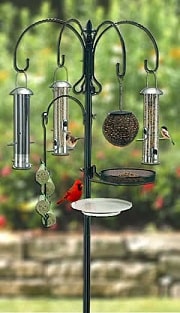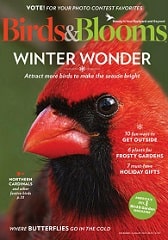Top Reasons Birds Stop Coming and Visiting Feeders
Where Have the Birds Gone?
I'm often asked by someone why birds have suddenly stopped coming to their backyard feeders. It doesn't matter if you're in the U.S., the UK, or Australia, the reasons are the same.
It may even be more specific, such as "Why have the Goldfinches disappeared". Or even more often, "Where did the Orioles go".
Surprising to many birdwatchers is the fact that some birds you see at your feeder in the morning may not be the same birds you see in the late afternoon.

As birds are continually searching for food, those that come in the morning may be far away by afternoon.
Those you see in the afternoon were most likely feeding far away in the morning. Of course, some birds are territorial and are around throughout the day.
Understanding how birds behave when it comes to feeding can help you understand what it means when they've stopped showing up. Here are some things to look for.
6 Reasons Birds May Have Stopped Coming to Your Feeders
- Bird Predators: Birds have many predators and are extremely vulnerable while feeding.
Cats roaming near feeders will cause birds to stop coming around. Hawks in nearby trees or soaring overhead will cause a sudden disappearance of feeder birds.
Coopers and Sharp-shinned Hawks are common in neighborhoods. Just because you haven't seen one doesn't mean they are not around.
It's so common that we've written a page about what to do when you see them around. The link is at the end of this article.
- Food Types: The types of food available can influence why birds may not be showing up at your feeders.
It may mean that the inexpensive seed you bought contains seeds such as red or white milo, and wheat, which doesn't attract many songbirds.
These types of bird seed originated in the poultry industry. Most wild birds are not attracted to these cheaper types although House Sparrows and some ground-feeding species are.
If you want to keep them coming back, offer Black-oil Sunflower Seed it's the one seed that will attract the biggest variety of birds.
Try a tray feeder. Skittish birds are attracted to this type of feeder as it offers a quick escape from flying predators.
Just don't offer your most expensive seed as any bird or mammal will have easy access to this type of feeder.
- Natural Food: As you would expect, birds are attracted to natural food sources. This behavior is ingrained in their DNA.
Their survival is dependent on their ability to know and find natural food sources.
Weather can be a factor in the availability of natural foods.
When winters are mild or during spring and summer, birds will have more natural food sources available.
When this happens, bird feeders are going to be used less.
Birds are always on the lookout for food. It's their survival that is at stake.
Most birds never rely on a single feeding source or area for survival. Consider offering food in different places in your yard.
Species with specific diets or migratory patterns are at risk of extinction if their food sources are gone.
- Neighbors: Another reason your birds may have stopped coming to your feeders is that your neighbors have started feeding birds, and feeding them well.
Offering a bird feeding station filled with Black-Oil Sunflower Seed, nyjer seed, suet, and peanuts will draw more birds than a single feeder with one type of seed.
You can find more information on our types of bird seed page which has an chart to make it easy.
Given a choice, it isn't difficult to see where the birds will be feeding. By using the term neighbors, I don't mean next door.
Do not assume because none of your close neighbors are birdwatchers that you're the only source of food. That perfect site might be a mile away. That's nothing for a bird.
- Fledging: When young birds (fledglings) leave the nest, the adults continue feeding their young.
As one would suspect, the adults teach their young where to find food and what natural foods there are to eat.
Sometimes the young may be brought to your feeder, but more times than not, they'll go somewhere else.
Once fledging happens, territories expand. New birds will find your feeders and your regulars will move on.
- Migration: It happens sooner than you think. For example, Orioles can begin migrating as early as July.
By September, most migrating species will begin to head south for winter.
This can also be a great time to see new types of birds at your feeders as migrating birds pass through and winter residents move in.
If you're offering only one type of seed, make sure it's Black-Oil Sunflower Seed. This type of seed attracts the most species of birds.
So How Can You Get the Birds Back to Your Feeders
Sometimes it's as simple as waiting out the weather and/or changing and offering more food choices.
As it gets colder, the bird's natural sources become less available and your feeders become more attractive.
Provide Water! Many people forget that birds need water to survive and in winter, water can be hard to come by.
Offering a Heated Birdbath to the birds in your backyard can be a lifesaver and set you apart from other bird watchers in the neighborhood.
Predators can be difficult, but with a little effort, you can overcome the problems they present.
You may have to get creative, but you can do something about them, such as making sure to have baffles on pole feeders for climbing predators.
Building a brush pile will also go a long way in protecting the birds from hawks. Small birds can dart into them quickly.
Learn How to Attract More Birds to Your Backyard.
If hawks are an issue please see: Hawks at Feeders
The 8 Styles of Bird Feeders You Should Consider to Keep Birds Coming Back.



